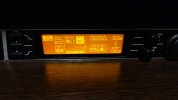I'd be wary... Mine crapped out just laying on a shelf; seems to be a cap that blew up in the power section, and I'm not the 1st person who's had similar issues with Beh. Behringer is 'good' because it's cheap and works fairly well, but the unavailability of the unit might be a blessing in disguise. Sweetwater shows "$349.00", and I don't recall it mine being that expensive, but I think I might have gotten mine used...
Have you looked into mindDSP?
https://www.minidsp.com/products/minidsp-in-a-box/minidsp-2x4-hd looks like it can do delay, it has TOSLINK input, so if you can use that, I'd personally go for that over a DEQ! Much smaller, I'd wager more reliable, probably also more powerful in terms of EQ. Lack direct interface/control, anyhow!
